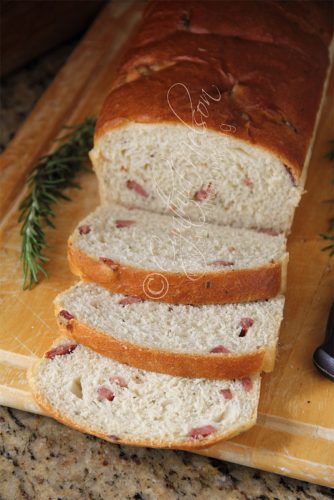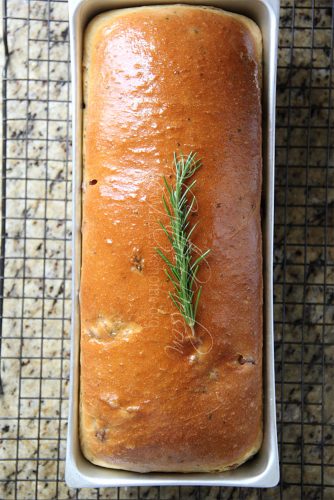 Things we make with ham from Christmas after the main feast include ham bone soup, fried veggies with bits of ham, fried rice and chow mein with strips of ham and the final scraps in a pot of Cook-up Rice. Well here’s another way to use up leftover ham – put it in bread along with some fresh rosemary and you’ll have a delicious loaf that you can eat on its own with simply a pat of butter. Or. Here’s an idea – still make the hambone soup and serve it with this bread. Yum!
Things we make with ham from Christmas after the main feast include ham bone soup, fried veggies with bits of ham, fried rice and chow mein with strips of ham and the final scraps in a pot of Cook-up Rice. Well here’s another way to use up leftover ham – put it in bread along with some fresh rosemary and you’ll have a delicious loaf that you can eat on its own with simply a pat of butter. Or. Here’s an idea – still make the hambone soup and serve it with this bread. Yum!

This bread is not so much about a particular recipe. I’ll share with you how I made the bread, but if you have a go-to recipe for bread, whether white, whole-wheat or multigrain, then use that, simply add in the recommended quantity of herbs and ham. This is not the first time I have made this type of bread but never before with ham. In the past I have used Linguiça calabresa – a Brazilian cured spicy sausage. All types of cured sausages are available year-round, so this bread is good to make at any time as opposed to having to wait for an occasion to have ham.
For 16 ounces of flour – regardless of the type of flour you are using for your bread – you will need a heaped cup or 1¼ cups of diced ham or sausages; a quarter-inch dice is ideal. For the herb, Rosemary, only use fresh; you’ll need a heaped tablespoon, or 1 tablespoon and 1 teaspoon finely chopped fresh rosemary.
Here’s what I used and how I made the bread.
HAM & HERB BREAD
Pan sizes: 1 (12 x 5) loaf pan or 2 (8 x 4 or 9 x 5) loaf pans
INGREDIENTS
● 1 pound (16 ounces) white all-purpose flour, plus extra for
the work surface
● 1 teaspoon dried instant yeast
● 2 tablespoons granulated sugar (white or brown)
● 1 teaspoon fine table salt
● 1½ tablespoons unsalted butter
● 1¼ cups chopped ham or cured pork sausage
● 1 heaped tablespoon finely chopped fresh rosemary
● Vegetable oil
● 2½ – 3 cups room temperature water
● Melted butter to brush dough (optional)
DIRECTIONS

1. In a large bowl, mix together the flour, yeast, sugar, and salt.
2. Rub the butter into the flour mixture.
3. Add the ham and herbs to the flour mixture and toss to evenly distribute.
4. Start with 2 cups of water first, continue to add just enough water to bring the dough together. When the dough comes together, turn on to a floured work surface and knead for 12 minutes, lightly dusting with flour if needed.
5. Rub oil all over the dough as well as the bowl and transfer the dough to the oiled bowl. Cover with a kitchen towel, plastic wrap or cover and place somewhere warm to proof for 90 minutes (1½ hours).
6. Brush pan or pans if using 2, with oil and set aside.
7. Turn risen dough onto the work surface and press down all around to remove the gas/puffiness of the dough. Divide evenly if making 2 loaves. Shape and roll the dough to match the length of the pan/pans and transfer to the pans to rise. Cover and let rise for 40 minutes.
8. 20 minutes into the second rise, preheat the oven to 375 degrees F.
9. At the end of the 40 minutes, transfer the pan/pans to the oven and bake for 25 – 30 minutes or until the bread is browned at the top and sounds hollow when tapped.
10. Remove the pan/pans from the oven, brush with melted butter if using and rest for 7 minutes in the pan before turning out and placing on a wire rack to cool.
11. Let bread rest for an hour before cutting.
NOTES
The dough can be shaped any way you like, for example, braided. Or you can opt to make bread rolls. This dough will easily make 12 to 14 rolls.
Cynthia
cynthia@tasteslikehome.org








